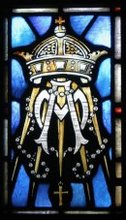The Second chapter of this Gospel, with its short 25 verses, presents two very important scenes from the life of Jesus. I will present this chapter in three sections. First I will post the translation of the section describing the wedding feast at Cana with questions to ponder in the form of a brief commentary. Then I will post the translation of the section describing the cleansing of the Temple also with reflection questions. In the third post related to this chapter I will attempt to provide you with a key to unlock the deep spiritual truth of the two events of the chapter.
Before we look at the first section of the chapter I wish to give you a clue to understanding the depth of this Gospel so that as we go on your experience will be enriched.
I offer you a different way to read this Gospel. I would like you to imagine that the Gospel has only two "characters." The primary character is Jesus of course. The other character is you. You are the totality of all the other players mentioned. Each other person mentioned in the Gospel is a different aspect of your personality. The collective cast of people in the story makes up the complete you.
Does that sound a little abstract? Maybe it will at first, but try and follow this idea. We are never really told for sure who the author of this Gospel is meant to be. Even in the references within the Gospel, the author is called "the beloved disciple" or "the one whom Jesus loved" or other like descriptions. If we understand the name John (as I described in the commentary of the first chapter) as a stage of human development and not simply as a particular individual, then we can view the one called "John-the beloved" as any person who is able to attain a personal loving relationship with Jesus. I certainly hope that you fall into that category.
If we embrace this idea we can then understand this Gospel as a sort of roadmap of discipleship. We can read the Gospel not as a strictly historical document (about a group of people in first century Palestine) but as a personal guide to spiritual growth. It becomes a living---right now---personal document.
Here is my challenge to you: As you read the Gospel, ask yourself which characters represent the most accurate picture of you. See if you can truly see yourself in the role of the "beloved disciple." I don't mean see if you can imagine yourself "playing" the role in first century Palestine, but are you---right now---in your life the beloved of Jesus? or are you one of the accusors? or are you the blind person who is healed? etc...
As you experience this Gospel imagining yourself as every person in the story except Jesus, I also want you to look deeper at the events of the Gospel as if they are happening to you. Here is what I mean: in the event of the cleansing of the Temple, you are the Temple. Examine what would happen if Jesus were to truly enter your life during an average day of your usual business. What would he find you doing? Would he have reason to act as he did upon entering the Temple? In every event we encounter I will guide you in the commentary to consider how the event/miracle/preaching either changed or didn't change the worldview of those who witnessed the event. Then I will ask you to ponder whether or not Jesus has been able to have the same effect on your true worldview.
Now, this will not be the way I will ask you to approach the entire Gospel. As we enter the chapters containing the Last Supper Discourses, I will ask you to shift entirely from this way of reading the Gospel to a different perspective. I will then present a third perspective when we enter the chapters of the Passion. I can assure you that the shifts will amaze you and you will experience an explosion of Godly light that will change the way you experience life itself.
I promise you solemnly, this way of experiencing this Gospel is nothing less than transformative. So now let us begin the first section of chpater 2:
We are about to encounter the first and definitive miracle of Jesus. In order to appreciate its significance one must first uncover the mystery behind the meaning of the terms “wine” and “water.” Besides these key terms you will have to go beneath the surface to find the deeper spiritual meaning presented in this chapter of the Gospel. I promise you solemnly: if you imagine the type of wedding scene often represented in cinematic portrayals of the Gospel message, you will miss the mark here. Remember that the meaning or essence existed before the image that represents the story. What is a marriage feast? Don’t “picture it” but instead understand the meaning it tries to convey. Come to know the words, intimately and as precisely as possible. “Take nothing with you on this journey!” That means that you must leave behind any images that may distract you from discovering the truth of this essential miracle of Jesus. I will state this: the miracle of the wedding feast deserves volumes written about its meaning. Since it is surely not the moment to make a digression of encyclopedic proportion I will endeavor to point out only a few ideas for you to ponder. Even after stating this I wish that there was a way that I did not have to present such a cursory commentary on this miracle, however this little blog is meant as an introduction only and my more complete commentary will follow in a printed version.
I will give you a clue to begin your reading of this chapter: notice the “when” of the feast. It takes place “on the third day.” This reference is very significant. It does not refer to three 24-hour periods after the call of Nathaniel in chapter one. Of this I assure you. The reference to the wedding feast occurring “on the third day” should speak to you directly. “The Third Day” is not a singular event in past history. It is a reference to the conversion and resurrection experienced by anyone who experiences the transcendence of participation in divine life. Essentially all followers of Jesus are called to their own “third day” and their own personal experience of the wedding feast.
1. On the third day, there was a wedding feast in Cana, a city of Galilee and the mother of The Jesus was there.
2. Also The Jesus and his disciples were invited to the wedding feast.
3. The wine was running out and his mother said to The Jesus, “They have no wine.”
4. The Jesus said to her, “What is it to you and to me? Woman, my hour has not yet arrived.”
5. His mother said to the servants, “Whatever he says to you, do it.”
6. There were six jars of stone that were set there for the purification of the Jews which each held two or three measures of water.
7. The Jesus said to them, “Fill the jars with water.” They filled them to the very top.
8. He said to them, “Draw some now and take it to the master of ceremonies.” And they took it.
9. When the master of ceremonies tasted that water that had become wine and did not know from where it came (but the servants knew because they had filled the water), he called to the groom.
We return to the importance of the central symbol of wine and now we experience the juxtaposition of the symbol of water. Again, this blog is simply an introduction to this translation and commentary. In the printed version we will explore more fully the symbols of water and wine. There are many ways to understand this miracle. For the moment I will offer you an idea to ponder. Let us imagine that the wedding feast is the marriage of the disciple’s mundane self with the spiritual bride of the divine self. The earthly/human element, is joined to the heavenly/spiritual element, becoming one person who is now a divine child of God.
10. He said, “Everyone first brings good wine and when they are drunk, that which is inferior. But you have kept the good wine until now.”
11. This was the first sign that The Jesus did in Cana of Galilee and made known his glory and his disciples believed in him.
12. After this he went down to Capernaum, he and his mother and his brothers and his disciples and they stayed there a few days.
Ask yourself the following questions:
- Have I experienced the wedding of my worldly self with my spiritual self?
What does this mean? The idea of marriage relates to a bond of unconditional love that makes two into one. Marriage is a unity. In a successful marriage there is harmony and honesty. A true partnership exists in a successful marriage. Does this describe you in that your bodily/worldy aspect is in harmony with your spiritual/intellectual aspect. If you are at odds with yourself it will be difficult for you to follow the way of Jesus. You are the couple.
In this part of the Gospel we can imagine that the wedding scene is actually a person who is trying to reach a place of balance in life---an end to any conflict between human needs and desires and spiritual/intellectual ideals. The person, who is both body and spirit, is trying to maintain a happy relationship between the two. The person is trying to have a good marriage.
Marriage takes committment. It is not uncommon for a married couple to experience testing along the path of married life. In the same way, the person can experience the same struggles in the internal marriage of body and spirit. Continuing with the imagery of the Gospel account we see this struggle presented in relation to the wine.
Wine is a symbol of joy and divinity. If the marriage feast here is our inner marriage, then the wine is our inner joy or our inner share in the experience of the divine life in Christ. When the wine runs out it can be understood as the person running out of the joy of life. This is experienced when there is an imbalance in the marriage of body and spirit. If Jesus is invited to your wedding feast he is able to work this miracle for you. He is able to turn the water of human struggle into the wine of human joy...but as we see there is another element.
Jesus not only brings the joy/wine back to your inner marriage feast, he brings better wine. Jesus brings a joy that is not merely a human joy/wine but a divine joy/wine. The miracle of the wedding feast is essential because it has many layers of importance. For now, I think we have covered enough.
As I mentioned above, it will not be possible to give any sort of exhaustive commentary on this essential miracle, but I do hope that the brief reflection here has opened up a new way for you to personalize this event of the Gospel. I also hope that you begin to see the myriad reasons why this is the quintessential first experience of the conversion of discipleship.
I will work to post the next section of this chapter over the next week. Please e-mail me with any comments or reflections you may have concerning this section at dominicanvocations@hotmail.com


